- News
- Reviews
- Bikes
- Accessories
- Accessories - misc
- Computer mounts
- Bags
- Bar ends
- Bike bags & cases
- Bottle cages
- Bottles
- Cameras
- Car racks
- Child seats
- Computers
- Glasses
- GPS units
- Helmets
- Lights - front
- Lights - rear
- Lights - sets
- Locks
- Mirrors
- Mudguards
- Racks
- Pumps & CO2 inflators
- Puncture kits
- Reflectives
- Smart watches
- Stands and racks
- Trailers
- Clothing
- Components
- Bar tape & grips
- Bottom brackets
- Brake & gear cables
- Brake & STI levers
- Brake pads & spares
- Brakes
- Cassettes & freewheels
- Chains
- Chainsets & chainrings
- Derailleurs - front
- Derailleurs - rear
- Forks
- Gear levers & shifters
- Groupsets
- Handlebars & extensions
- Headsets
- Hubs
- Inner tubes
- Pedals
- Quick releases & skewers
- Saddles
- Seatposts
- Stems
- Wheels
- Tyres
- Health, fitness and nutrition
- Tools and workshop
- Miscellaneous
- Tubeless valves
- Buyers Guides
- Features
- Forum
- Recommends
- Podcast
TECH NEWS
First Ride: Pinarello Dogma K8-S
The Pinarello Dogma K8-S is a road bike with rear suspension that really does make a big difference to the character of the ride, taking the edge off uneven surfaces and softening the impact of larger lumps and bumps.
You know all about the Dogma, right? The Dogma F8 is the bike that Chris Froome rode to victory in the Tour de France last month. Then there’s the Dogma F8 Disk that Team Sky raced for the first time in the Eneco Tour a couple of weeks ago.

The Dogma K8-S is very different from either of those two in that it features rear suspension – what Pinarello calls a DSS 1.0 shock between the seatstays and the seat tube with travel that relies on flex in the chainstays.
We first showed you the Pinarello Dogma K8-S when it was lauched back in April.
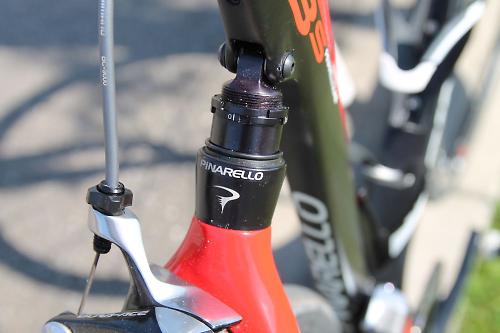
Why would you want to complicate a road bike by adding suspension? The idea is to provide a smoother ride over dodgy surfaces. In the case of the pros, that could make a difference in races that involve cobbles, like Paris-Roubaix.
According to Pinarello, “The Dogma K8-S is the result of a specific request of Team Sky: to have an innovative frame able to reduce the psycho-physical stress of the athletes, and thus increase the performance in the Hell of the North.
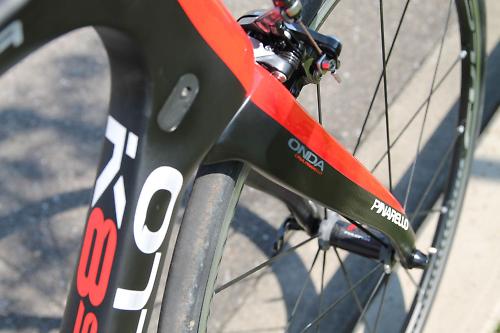
“As with the Dogma F8, we assembled our team of Italian and British engineers, who collaborated to put on the road a bike with well-defined characteristics: vertically compliant yet stiff at the same moment and of course maintaining the weight of a road bike.”
Great use of some of cycling’s best loved clichés there!
“We designed a lightweight suspension system in combination with the new carbon chainstays, able to flex, in order to create a pivot point for the perfect riding comfort.”

Pinarello's use of the phrase 'pivot point' is a little confusing. There are no pivots; the chainstays flex enough for the shock to compress, like you see on a soft-tail mountain bike (there’s nothing new under the sun!).
Pinarello says that the front triangle of the Dogma K8-S is very similar to that of the Dogma F8 with just a slightly altered geometry.
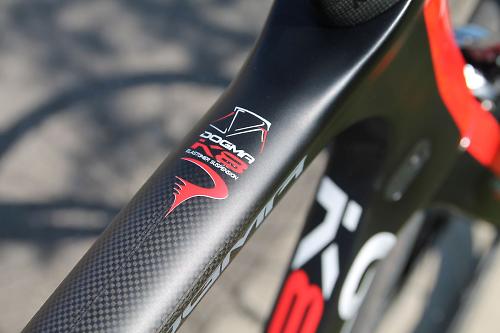
Pinarello claims that the frame, complete with suspension, weighs 990g (53cm model), and that it improves rider comfort by as much as 50%.
For the full tech background to the bike, check out our original story from the launch.
I must say that the whole K8-S story set the klaxons on my BS detector blasting out at 150 decibels. I mean, “The overall performance of Dogma K8-S is 4.6% greater than Dogma K 2015, in terms of handling and comfort”. What are you supposed to make of a claim like that?
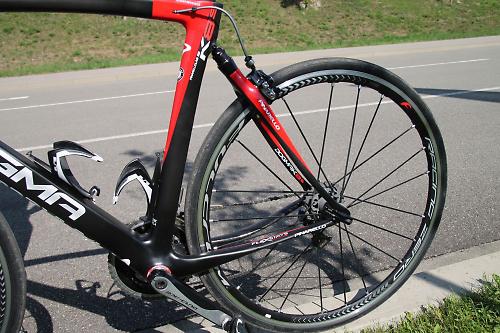
But I got the chance to go for a ride on the Dogma K8-S and I must say that it does do what Pinarello claims.
I started out riding it over the bumpiest bits of asphalt that I could find, then hitting all the drains and manhole covers in Friedrichshafen. You feel this stuff, but not as much as normal on a road bike.
That got me searching for badly surfaced roads. There are a bunch of gravel roads around here; you know the sort of thing – holes, bumps, the occasionally bit of mud. The Dogma K8-S smooths them over. Not at the front, obviously, because there’s no suspension in the fork, but the ride is appreciably softer at the back.
There’s really not a whole lot of travel on offer here. We’re talking about a few millimetres. That’s not much but it’s enough to affect the ride. I was genuinely surprised. It’s the difference between getting shaken up and down in the saddle on a gravel road (I couldn’t find any cobbles), and feeling more comfortable and in control. Significant.
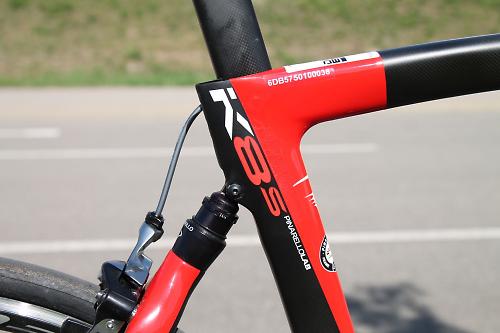
What cutting-edge suspension medium is Pinarello using here? Um, elastomer.
If you’re from a mountain bike background you’ll know that this is a material that was used for off-road suspension back in the days when Queen Victoria first got phat air on the Windsor Castle doubles. You’ll be scoffing at these roadies for slinging it on the back-end of a high-end carbon frame. But what can I say? Okay, it’s not the most sophisticated system ever and I didn’t have a particularly long time aboard the Dogma K8-S, but it felt good on my ride through the woods (yes, I know the pics are on the road).
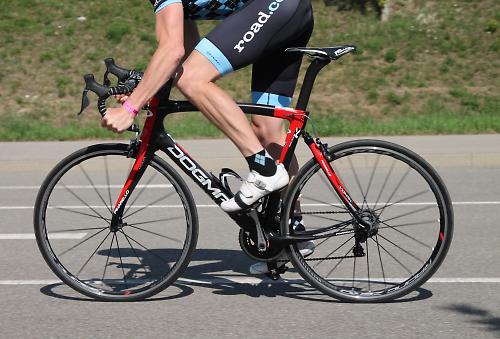
The Dogma K8-S feels nippy and alive too. The 58cm model I rode weighed in at 7.46kg (16.4lb). That’s pretty light, even though the shock adds a little weight, of course (there’s no such thing as a free lunch!). The bike accelerates well and you can chuck it around easily when you get out of the saddle.
Downsides? Well, I did find that the back end would move a bit when sprinting out of the saddle, giving the Dogma K8-S a bit of a squidgy feel in that situation. But, on the whole, I think the bike is successful in that it delivers a smoother ride across rough roads. It isn’t a gimmick. The riding you do might or might not benefit from a bike of this type, but I’d certainly love to give it a go over the cobbles.
Mat has been in cycling media since 1996, on titles including BikeRadar, Total Bike, Total Mountain Bike, What Mountain Bike and Mountain Biking UK, and he has been editor of 220 Triathlon and Cycling Plus. Mat has been road.cc technical editor for over a decade, testing bikes, fettling the latest kit, and trying out the most up-to-the-minute clothing. He has won his category in Ironman UK 70.3 and finished on the podium in both marathons he has run. Mat is a Cambridge graduate who did a post-grad in magazine journalism, and he is a winner of the Cycling Media Award for Specialist Online Writer. Now over 50, he's riding road and gravel bikes most days for fun and fitness rather than training for competitions.
Latest Comments
- pockstone 15 min 4 sec ago
Tried to like this and got 'threaded ' comments instead.
- Secret_squirrel 19 min 36 sec ago
Thanks for the insurance explanation, it's a bit of a sly headline calling the driver uninsured if 3rd party claims are dealt with differently in NZ.
- chrisonabike 20 min 4 sec ago
Counter argument is that if the problem is crap infra (cycle lanes, shared space, ASLs...) the fix is "proper infra". But in the UK it it's often...
- Jakrayan 29 min 26 sec ago
Wouldn't they just charge your credit card rather than insist on a direct debit? And the cardholder's address is not shared with the merchant by...
- chrisonabike 32 min 32 sec ago
To be fair, he'd only be riding in a cycle lane where it wasn't a bus lane, a side road or a junction. Cycle lanes always vanish when one of those...
- Hirsute 1 hour 7 min ago
I thought that was obvious when you wrote rule 28 which is clearly part of 'the rules'. Section 28 is not a rule but a piece of legislation hence...
- qwerty360 1 hour 10 min ago
Remember, any driver flashing headlights for you to proceed should be assumed to be a crash for cash scam. ...
- Wheelywheelygood 2 hours 46 min ago
This is just a joke certainly in any tvp area they can't even police themselves let alone anything else all their interested in is fineing...
- scimos 3 hours 3 min ago
last time I went a few years ago seat tickets gave you access to the central area, yes.
- ktache 5 hours 2 min ago
I think many motorists would be shocked how much, what essentially is theft insurance, is for bicycles. Though mostly for the priciest, the cheaper...

















Add new comment
3 comments
I've talked with a few other riders who have ridden the K8-s (and as well read all the press articles) and no one has spoken about this bike as bobing much at all under out of the seat grinding. Perhaps the shock was not fully adjusted? Or maybe certain frame sizes and riders weights make the shock work differently than others. It seems there is more testing to do on this bike, both by the manufacturer and by journalists. Indeed I wonder if the only way to truly get to bobing completely out of the equation is to design a shock that separate the forces of bumps from pedaling- making the shock move in a vertical axis only resulting from bumps and not affected by pedaling. Or maybe the elastomer really is good enough and its just a matter of getting the adjustments right for every type of rider. Seems as if this is the most serious attempt yet by a manufacturer at actually getting rear suspension right for the road. Good engineering all around.
Or you could just make the frame and forks to fit tyres with a bit more air volume...
Well, I was wondering what it co... Oh, yes, of course. Sorry I wasn't thinking. I'll just get my coat.